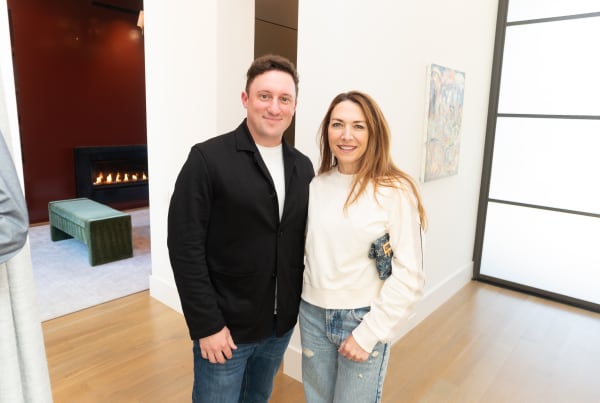In Chambre d'Amis: Dallas Edition 2, Emmanuel Van der Auwera and Lucia Simek (Executive Director, Dallas Contemporary) spoke about the emotional currency of images and the assembly of the real, discussing a range of subjects from rare earth minerals to various forms of automation.
The following viewing room includes documentation of this event, as well as a presentation of the works discussed.
Thank you to Peter, Brad, Lucia, Tammy and everybody who turned up for a fantastic second edition of Chambre d’Amis (Dallas), hosted at the Augustus Owen Foundation.
-

-
BIO
Van der Auwera is a 2015 laureate of the Higher Institute for Fine Arts (HISK) post-academic course in Ghent (BE), a 2015 Langui Award recipient of the Young Belgian Art Prize, and the first winner of the Goldwasserschenking awarded by the WIELS Contemporary Art Centre and the Belgian Royal Museums of Fine Arts (BE). His work has been the subject of solo exhibitions at institutions including HEK - Haus der Elektronischen Künste (Basel, CH); Photoforum Pasquart (Biel, CH); IKOB - Museum of Contemporary Art (Eupen, BE); Le Botanique (Brussels, BE); CAP - Centre d’Art Contemporain de Saint Fons (Lyon, FR). Van der Auwera has participated in group exhibitions at the Palais de Tokyo (Paris, FR); Pinakothek der Moderne (Munich, DE); KW Institute for Contemporary Art (Berlin, DE); WIELS Contemporary Art Centre (Brussels, BE); Kunsthal Charlottenborg (Copenhagen, DK); Deichtorhallen Hamburg (Hamburg, DE); Galerie Rudolfinum (Prague, CK); 8th Yokohama Triennale (Yokohama, JP); Centre Wallonie-Bruxelles (Paris, FR); Kunsthalle Wien (Vienna, AT); Jeu de Paume (Paris, FR); and many others.
His work has been acquired by the MAC's - The Wallonia-Brussels Federation Museum of Contemporary Arts (Grand-Hornu, BE); ARGOS centre for audiovisual arts (Brussels, BE); Musée d’Ixelles (Brussels, BE); Mu.ZEE (Ostend, BE); Collection de la Province de Hainaut - BPS 22 (Charleroi, BE); KANAL - Centre Pompidou (Brussels, BE); KADIST (Paris, FR); Fundación Otazu (Pamplona, ES); the Stockholm School of Economics (Stockholm, SE); the Art Vontobel Collection (Zurich, CH); the Jordan Schnitzer Museum of Art (Eugene, US); and Dallas Museum of Art (Dallas, US). In 2020, Yale University Press & Mercator Fonds published a monograph dedicated to his work.
-
-
-
-
-
-
-
-
-
Memento
-

Memento 2, 2016
-

Memento 11, 2018
-

View of "FULL A.L.I.C.E", Photoforum Pasquart, Biel, Switzerland, 2022
-

Memento 15 (Study for Nuit Américaine), 2018
-

Memento 19 (Red V, Study for Nuit Américaine), 2018
-

View of "White Noise", 214 Projects, Dallas, US, 2019
-

Memento 26 (Tehran), 2020
-

Memento 32 (Capitol Red), 2021
-

View of "This Is Us ", Z33, Hasselt, Belgium, 2023. Photo Credit Selma Gurbuz.
-

View of "FULL A.L.I.C.E", Photoforum Pasquart, Biel, Switzerland, 2022
-

Memento 51 (Boston Marathon), 2023
-

Memento 56 (Study for Memento 43 - Migrant Crisis Blue), 2024
-

Memento 59 (Capitol Black), 2025
-

Memento 63 (Butler PA), 2025
-
-

Memento 58 (NOAH WAS REAL), 2024
Memento 58 (NOAH WAS REAL), 2024Newspaper .3mm aluminum offset plates mounted on aluminum frame275 x 302.5 x 2.5 cm
108 1/4 x 119 1/8 x 1 inAs light strikes the six panels, the image flickers in and out of view. These reflective metal surfaces—offset printing plates—have been diverted from their original industrial purpose and reimagined by Emmanuel Van der Auwera as part of Memento, a series spanning nearly a decade (2016–2025). In his hands, tools of mass reproduction become unique works of art: the plates, typically hidden within the newspaper-printing process, are transformed into luminous, painterly surfaces that explore light and depth.Over the years, Van der Auwera has pushed the boundaries of this medium, manipulating solvents to darken the plates or exposing them to bleach images almost into absence. Of the 63 works in the Memento series, Memento 58 (NOAH WAS REAL) stands alone in bringing together all of these formal techniques—a culmination that insists on the idea of repetition and return.The panels feature a 2022 Globe Magazine cover: a smiling child beneath the headline, “NOAH WAS REAL.” The text is always legible; the child’s image emerges only under certain light, often revealed through his eyes, from which the rest of his face must be reconstructed. His name is Noah Pozner, the youngest victim of the Sandy Hook Elementary School shooting. The photograph is his final yearbook portrait.The Globe article reflects on the Pozner family’s grief a decade after the tragedy—years shadowed by toxic conspiracy theories: that the grieving parents were actors, that Noah never existed, that the massacre was a hoax orchestrated by the so-called Deep State. These lies proliferated online, driven by alt-right figures like Alex Jones. At one point, Noah’s father, Leonard Pozner, was forced into hiding.Van der Auwera sees Sandy Hook as a critical rupture in the relationship between media and public trust—a moment when the cracks in traditional journalism became unmistakable. It marks, in his view, the beginning of the post-truth era. Nearly 13 years later, Memento 58 (NOAH WAS REAL) measures the emotional and cultural aftermath of that moment, closing the Memento series as offset printing itself fades into obsolescence; the newspaper plant where Van der Auwera once worked has since shut down.“The manner in which human sense perception is organized, the medium in which it is accomplished, is determined not only by nature but by historical circumstances as well.” In the delicate interplay of light and absence, Van der Auwera’s repetition of “NOAH WAS REAL” stands as a powerful tribute to the young boy whose life was stolen, a defiant rejection of the lies that sought to erase him, and a reminder that truth, despite its distortions, endures.1. Walter Benjamin, “The Work of Art in the Age of Mechanical Reproduction”, 1935, p.5
-
Thank you for joining us.
Photography by Exploredinary.














































